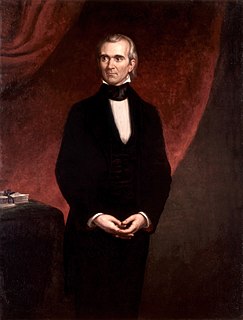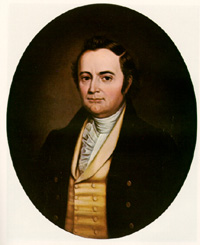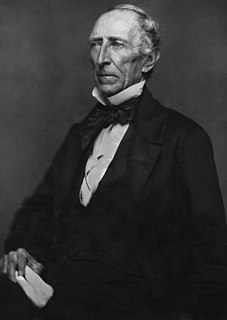
The Twenty-first United States Congress was a meeting of the legislative branch of the United States federal government, consisting of the United States Senate and the United States House of Representatives. It met in Washington, D.C. from March 4, 1829, to March 4, 1831, during the first two years of Andrew Jackson's presidency. The apportionment of seats in the House of Representatives was based on the Fourth Census of the United States in 1820. Both chambers had a Jacksonian majority.

The Twenty-third United States Congress was a meeting of the legislative branch of the United States federal government, consisting of the United States Senate and the United States House of Representatives. It met in Washington, D.C. from March 4, 1833, to March 4, 1835, during the fifth and sixth years of Andrew Jackson's presidency. The apportionment of seats in the House of Representatives was based on the Fifth Census of the United States in 1830. The Senate had an Anti-Jacksonian or National Republican majority, and the House had a Jacksonian or Democratic majority.

The Twenty-fourth United States Congress was a meeting of the legislative branch of the United States federal government, consisting of the United States Senate and the United States House of Representatives. It met in Washington, D.C. from March 4, 1835, to March 4, 1837, during the seventh and eighth years of Andrew Jackson's presidency. The apportionment of seats in the House of Representatives was based on the Fifth Census of the United States in 1830. Both chambers had a Jacksonian majority.

Elections to the United States House of Representatives for the 24th Congress were held in 1834 and 1835 during Andrew Jackson's second term in office.

Elections to the United States House of Representatives for the 19th Congress coincided with the contentious presidential election of that year. While the bulk of states held their elections in 1824, six states scheduled their general elections at various times during 1825.
The United States Senate elections of 1844 and 1845 were elections which, coinciding with James K. Polk's election, had the Democratic Party retake control of the United States Senate, gaining a net total of eleven seats from the Whigs.
The United States Senate elections of 1842 and 1843 were elections which had the Whigs lose seats but maintain control of the United States Senate. Although they lost three seats in the general elections, they gained two of them back by the start of the first session in special elections.
The United States Senate elections of 1840 and 1841 were elections which, corresponding with their Party's success in the 1840 presidential election, had the Whig Party take control of the United States Senate.
The United States Senate elections of 1838 and 1839 were elections which had the Democratic Party lose seven seats in the United States Senate, but still retain a majority.
The United States Senate elections of 1820 and 1821 were elections for the United States Senate that, corresponding with James Monroe's landslide re-election, had the Democratic-Republican Party gain seven seats, assuming almost complete control of the Senate.
The United States Senate elections of 1792 and 1793 were elections of United States Senators that coincided with President George Washington's unanimous re-election. In these elections, terms were up for the ten senators in class 2.
The United States Senate elections of 1836 and 1837 were elections that had the Jacksonian coalition emerge as the Democratic Party, and the Adams, or Anti-Jackson, coalition emerge as the Whig Party
The United States Senate elections of 1794 and 1795 were elections that had the formation of organized political parties in the United States, with the Federalist Party emerging from the Pro Administration coalition, and the Democratic-Republican Party emerging from the Anti-Administration coalition.
The United States Senate elections of 1832 and 1833 were elections that had the Anti-Jackson coalition assume control of the United States Senate from the Jacksonian coalition, despite Andrew Jackson's victory in the presidential election.
The United States Senate elections of 1830 and 1831 were elections that had Jacksonians gain one seat in the United States Senate from the Anti-Jacksonian coalition, but lose one seat to the short-lived Nullifier Party. By the time Congress first met in December 1831, however, the Jacksonians had a net loss of one seat.
In the United States Senate elections of 1828 and 1829, the Jacksonian coalition, despite its leader's victory in the presidential election, lost a seat in the Senate to the opposing Anti-Jacksonian coalition.
The United States Senate elections of 1826 and 1827 were elections that had the majority Jacksonians gain a seat in the United States Senate.
The United States Senate elections of 1822 and 1823 were elections for the United States Senate that had the Democratic-Republican Party continue almost complete control of the Senate.
The United States Senate elections of 1824 and 1825 were elections for the United States Senate that saw the Jacksonians gain a majority over the Anti-Jacksonian National Republican Party.
The 1834 United States elections occurred in the middle of Democratic President Andrew Jackson's second term. Members of the 24th United States Congress were chosen in this election. Taking place during the Second Party System, elections were contested between Andrew Jackson's Democratic Party and opponents of Jackson, including the remnants of the National Republican Party. During this election, the anti-Jackson faction began to transition into the Whig Party. Arkansas and Michigan joined the union during the 24th Congress. Democrats retained the majority in the House, and won control of the Senate.






